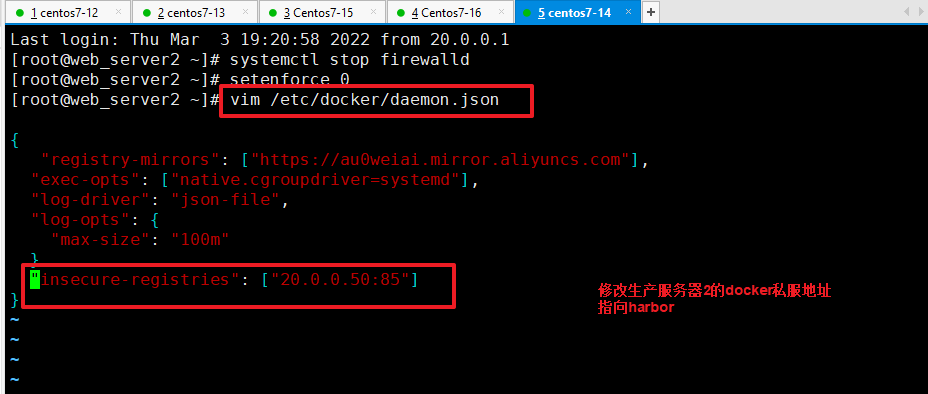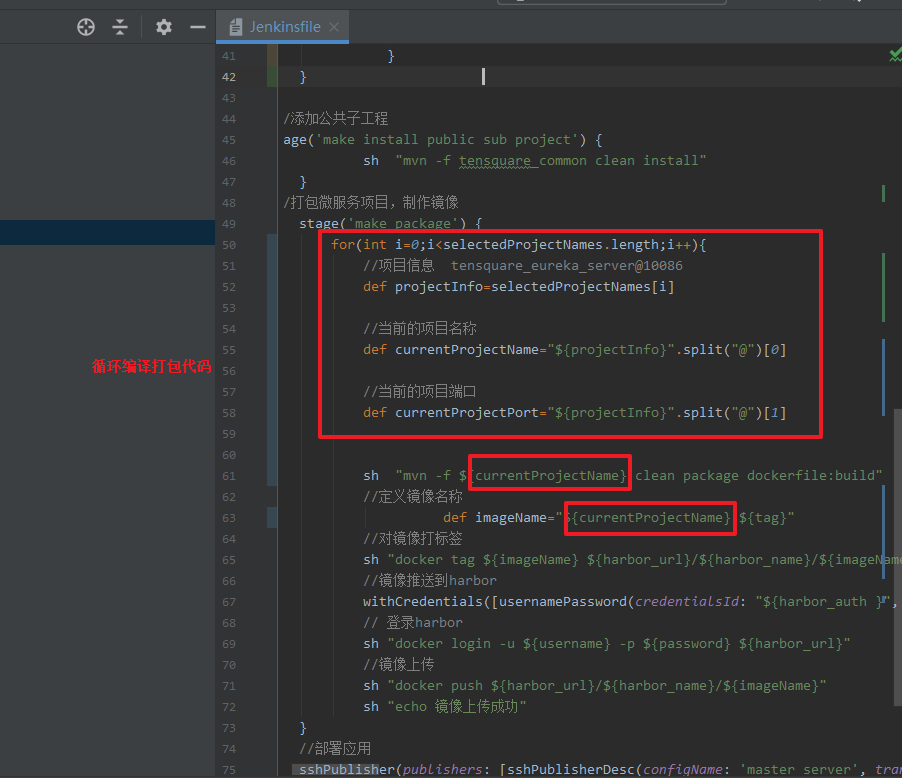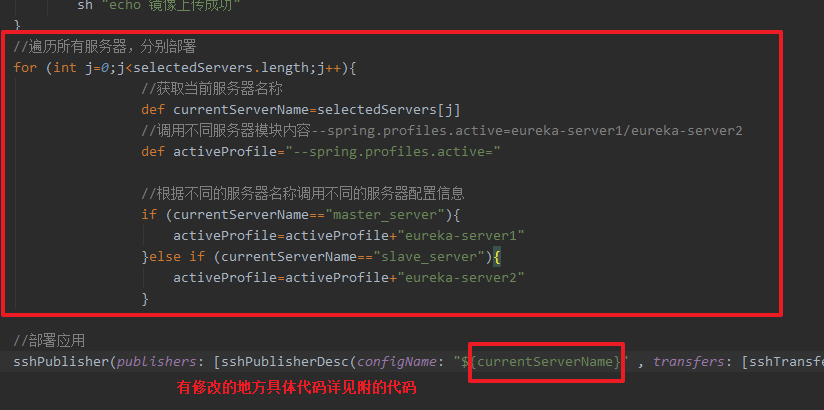Devops 开发运维高级篇之Jenkins+Docker+SpringCloud微服务持续集成——部署方案优化
Devops 开发运维高级篇之Jenkins+Docker+SpringCloud微服务持续集成——部署方案优化
之前我们做的方案部署都是只能选择一个微服务部署并只有一台生产服务器,每个微服务只有一个实例,容错率低
如何去解决?
- 在一个Jenkins工程中可以选择多个微服务同时发布
- 在一个Jenkins工程中可以选择多台生产服务器同时部署
- 每个微服务都是以集群高可用形式部署
Jenkins+Docker+SpringCloud集群部署流程说明
修改所有微服务配置:
再开一台生产服务器 装有docker环境
从jenkins服务器拷贝公钥去这一台生成服务器2的

然后修改docker的私服地址:

记得重启docker!
注册中心配置:(原来的单机版改成集群版)
1 2 3 4 5 6 7 8 9 10 11 12 13 14 15 16 17 18 19 20 21 22 23 24 25 26 27 28 29 30 31 32 | # 集群版spring: application: name: EUREKA-HA---server: port: 10086spring: # 指定profile=eureka-server1 profiles: eureka-server1eureka: instance: # 指定当profile=eureka-server1时,主机名是eureka-server1 hostname: 20.0.0.60 client: service-url: # 将自己注册到eureka-server1、eureka-server2这个Eureka上面去 defaultZone: http://20.0.0.60:10086/eureka/,http://20.0.0.40:10086/eureka/---server: port: 10086spring: profiles: eureka-server2eureka: instance: hostname: 20.0.0.40 client: service-url: defaultZone: http://20.0.0.60:10086/eureka/,http://20.0.0.40:10086/eureka/ |

其它微服务的配置:
1 2 3 4 5 6 7 8 9 10 | eureka: client: service-url: defaultZone: http://20.0.0.60:10086/eureka,http://20.0.0.40:10086/eureka/#上面的这个是eureka访问地址 instance: lease-renewal-interval-in-seconds: 5 # 每隔5秒发送一次心跳 lease-expiration-duration-in-seconds: 10 # 10秒不发送就过期 prefer-ip-address: true |

全部修改完就去吧代码提交到Gitlab中!push!
编写deployCluster.sh部署脚本,放到两台生产服务器中路径:/opt/jenkins_shell/deployCluster.sh
1 2 3 4 5 6 7 8 9 10 11 12 13 14 15 16 17 18 19 20 21 22 23 24 25 26 27 28 29 30 31 32 33 34 35 36 37 38 39 40 41 42 43 44 45 46 47 48 | #! /bin/sh#接收外部参数harbor_url=$1harbor_project_name=$2project_name=$3tag=$4port=$5profile=$6imageName=$harbor_url/$harbor_project_name/$project_name:$tagecho "$imageName"#查询容器是否存在,存在则删除containerId=`docker ps -a | grep -w ${project_name}:${tag} | awk '{print $1}'`if [ "$containerId" != "" ] ; then #停掉容器 docker stop $containerId #删除容器 docker rm $containerId echo "成功删除容器"fi#查询镜像是否存在,存在则删除imageId=`docker images | grep -w $project_name | awk '{print $3}'`if [ "$imageId" != "" ] ; then #删除镜像 docker rmi -f $imageId echo "成功删除镜像"fi# 登录Harbordocker login -u lvbu -p Lvbu1234 $harbor_url# 下载镜像docker pull $imageName# 启动容器docker run -di -p $port:$port $imageName $profileecho "容器启动成功" |
然后就是更改Jenkinsfile 代码!!增加循环构建编译打包!还有集群部署的代码!
1 2 3 4 5 6 7 8 9 10 11 12 13 14 15 16 17 18 19 20 21 22 23 24 25 26 27 28 29 30 31 32 33 34 35 36 37 38 39 40 41 42 43 44 45 46 47 48 49 50 51 52 53 54 55 56 57 58 59 60 61 62 63 64 65 66 67 68 69 70 71 72 73 74 75 76 77 78 79 80 81 82 83 84 85 86 87 88 89 90 91 92 93 94 95 96 | //git的凭证def git_auth="d5bb0e98-15f2-477f-8db7-2c33ecc6c644"//git的URLdef git_url="git@20.0.0.20:root/tensquare_back.git"//镜像标签def tag="latest"//harbor的url地址def harbor_url="20.0.0.50:85"//镜像仓库名def harbor_name="tensquare"//harbor的凭证def harbor_auth="da853891-2b06-4f40-ad1f-f833b0cd96b7"node { //获取当前选择项目名称 def selectedProjectNames="${project_name}".split(",") //获取当前选择服务器 def selectedServers="${publish_server}".split(",") stage('pull code') { checkout([$class: 'GitSCM', branches: [[name: "*/${branch}"]], extensions: [], userRemoteConfigs: [[credentialsId: "${git_auth}", url: "${git_url}"]]]) } stage('check code') { for(int i=0;i<selectedProjectNames.length;i++){ //项目信息 tensquare_eureka_server@10086 def projectInfo=selectedProjectNames[i] //当前的项目名称 def currentProjectName="${projectInfo}".split("@")[0] //当前的项目端口 def currentProjectPort="${projectInfo}".split("@")[1] //定义SonarQubeScanner工具 def scannerHome = tool 'sonar-scanner' //引用SonarQube系统环境 withSonarQubeEnv('sonarqube') { sh """ cd ${currentProjectName} ${scannerHome}/bin/sonar-scanner """ } } } //添加公共子工程 stage('make install public sub project') { sh "mvn -f tensquare_common clean install" } //打包微服务项目,制作镜像 stage('make package') { for(int i=0;i<selectedProjectNames.length;i++){ //项目信息 tensquare_eureka_server@10086 def projectInfo=selectedProjectNames[i] //当前的项目名称 def currentProjectName="${projectInfo}".split("@")[0] //当前的项目端口 def currentProjectPort="${projectInfo}".split("@")[1] sh "mvn -f ${currentProjectName} clean package dockerfile:build" //定义镜像名称 def imageName="${currentProjectName}:${tag}" //对镜像打标签 sh "docker tag ${imageName} ${harbor_url}/${harbor_name}/${imageName}" //镜像推送到harbor withCredentials([usernamePassword(credentialsId: "${harbor_auth }", passwordVariable: 'password', usernameVariable: 'username')]) { // 登录harbor sh "docker login -u ${username} -p ${password} ${harbor_url}" //镜像上传 sh "docker push ${harbor_url}/${harbor_name}/${imageName}" sh "echo 镜像上传成功" } //遍历所有服务器,分别部署 for (int j=0;j<selectedServers.length;j++){ //获取当前服务器名称 def currentServerName=selectedServers[j] //调用不同服务器模块内容--spring.profiles.active=eureka-server1/eureka-server2 def activeProfile="--spring.profiles.active=" //根据不同的服务器名称调用不同的服务器配置信息 if (currentServerName=="master_server"){ activeProfile=activeProfile+"eureka-server1" }else if (currentServerName=="slave_server"){ activeProfile=activeProfile+"eureka-server2" } //部署应用 sshPublisher(publishers: [sshPublisherDesc(configName: "${currentServerName}" , transfers: [sshTransfer(cleanRemote: false, excludes: '', execCommand: "/opt/jenkins_shell/deployCluster.sh ${harbor_url} ${harbor_name} ${currentProjectName} ${tag} ${currentProjectPort} ${activeProfile}", execTimeout: 120000, flatten: false, makeEmptyDirs: false, noDefaultExcludes: false, patternSeparator: '[, ]+', remoteDirectory: '', remoteDirectorySDF: false, removePrefix: '', sourceFiles: '')], usePromotionTimestamp: false, useWorkspaceInPromotion: false, verbose: false)]) } } }} |





然后继续提交push到gitlab中!!!
设计Jenkins集群项目的构建参数
安装Extended Choice Parameter插件

创建流水线项目:

添加参数:字符串参数:分支名称:

然后插件下好了就会有多选框:项目名称:



然后继续修改配置另一台生成服务器的:

新增多选框:



保存后
然后把gitlab的后端项目ssh复制一下url 下面会用到!


然后就可以开始构建看效果图:

然后就开始构建:




最后结果图!!!

访问两台生产服务器地址:20.0.0.60:10086 、 20.0.0.40:10086


另一台的生成服务器:看容器:

Nginx+Zuul集群实现高可用网关
docker2服务器上安装nginx
1 2 3 | #下载依赖源下载nginxyum install epel-release -y yum -y install nginx |
修改配置:
1 | vim /etc/nginx/nginx.confn |
内容如下:
1 2 3 4 | upstream zuulServer{ server 20.0.0.60:10020 weight=1; server 20.0.0.40:10020 weight=1;} |
1 2 3 | location / { proxy_pass http://zuulServer/;} |

保存后重启nginx:
1 | systemctl restart nginx |
然后去修改nginx前端的访问地址:

然后提交推送:


再次构建前端项目:

访问集群网站:

自古英雄多磨难
分类:
Jenkins





【推荐】国内首个AI IDE,深度理解中文开发场景,立即下载体验Trae
【推荐】编程新体验,更懂你的AI,立即体验豆包MarsCode编程助手
【推荐】抖音旗下AI助手豆包,你的智能百科全书,全免费不限次数
【推荐】轻量又高性能的 SSH 工具 IShell:AI 加持,快人一步
· 从 HTTP 原因短语缺失研究 HTTP/2 和 HTTP/3 的设计差异
· AI与.NET技术实操系列:向量存储与相似性搜索在 .NET 中的实现
· 基于Microsoft.Extensions.AI核心库实现RAG应用
· Linux系列:如何用heaptrack跟踪.NET程序的非托管内存泄露
· 开发者必知的日志记录最佳实践
· TypeScript + Deepseek 打造卜卦网站:技术与玄学的结合
· Manus的开源复刻OpenManus初探
· 写一个简单的SQL生成工具
· AI 智能体引爆开源社区「GitHub 热点速览」
· C#/.NET/.NET Core技术前沿周刊 | 第 29 期(2025年3.1-3.9)